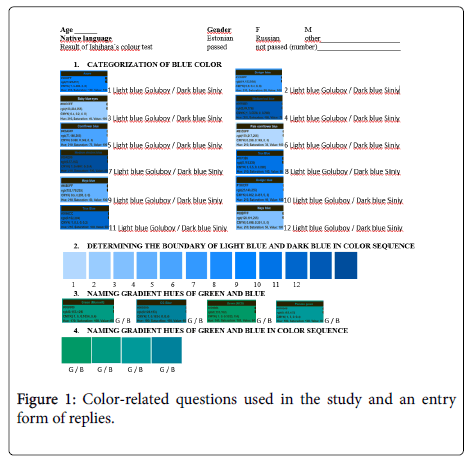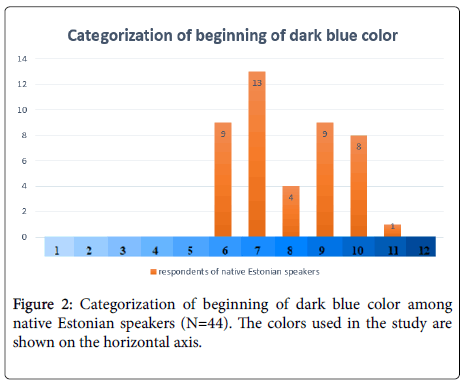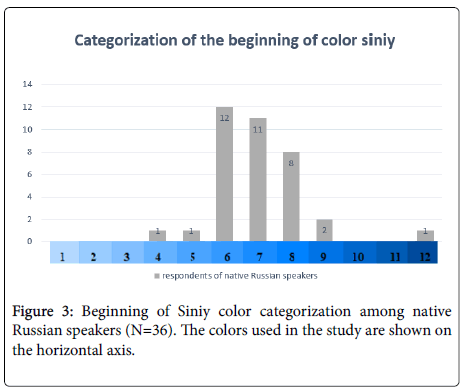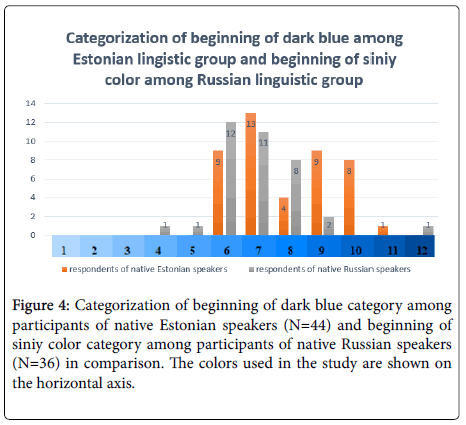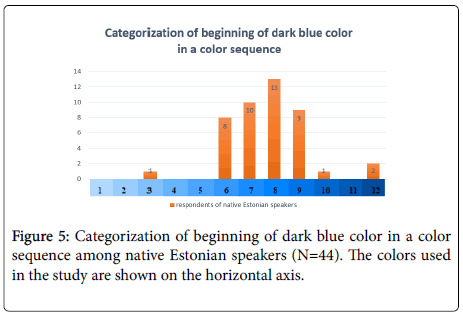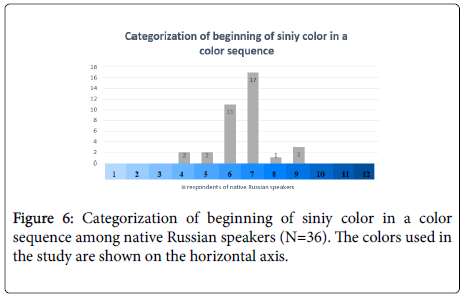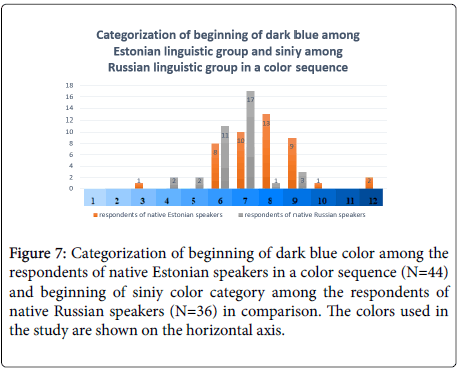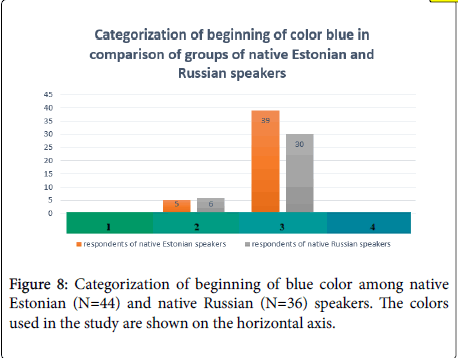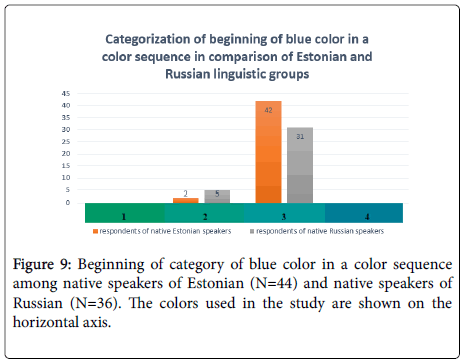Color Perception, Linguistic Categorization of Colors in Different Languages and the Role of Language in Color Perception based on Estonian and Russian Languages
Received: 03-Mar-2020 / Accepted Date: 19-Mar-2020 / Published Date: 26-Mar-2020 DOI: 10.4172/2476-2075.1000138
Abstract
Color perception does not have critical importance from the perspective of survival in modern society; however the ability to discriminate colors enriches the image of visually perceivable world significantly. A human eye can see millions of color hues, at the same time cultural differences play an important role in color perception, which has been influenced by color practices and traditions in a concrete linguistic environment. This study focuses on the influence of a language, and on color perception, based on an example of Estonian and Russian languages. Mixed method is used in the study, the role of the language on influencing color perception is analyzed on an example of Estonian and Russian languages; based on Estonian helesinine light blue and tumesinine dark blue color and Russian goluboy (голубой) and siniy (синий) color categorization and category boundaries. Also, categorization of gradient colors of green and blue among native Estonian and Russian speakers is being analyzed. The results: beginning boundary of dark blue color based on the Estonian language does not match the beginning boundary of the Russian language-based siniy color. The category of dark blue begins perceivably from darker blue color than the category of siniy. Siniy beginning boundary is expressed more specifically by the speakers of Russian, it is more clearly determined than the beginning boundary of dark blue color category among the native speakers of Estonian. Naming and categorization of gradient colors of blue and green vary, which is resulting from comparison of Estonian and Russian language groups; it also varies on setting the task differently within the same language group, and in both study groups, the one of native Estonian speakers and of native Russian speakers. The boundary of green and blue color is not clearly determined in the Estonian language; therefore, the gradient colors of blue and green categories can be perceived equally as greenish-blue or bluish-green. Therefore, based on an example of Estonian and Russian languages, it can be confirmed that color perception is influenced by culture through the language.
Keywords: Color perception; Linguistic categorization; Language; Culture
Introduction
Color perception provided human´s ancestors with a prerequisite for evolution. Although color perception does not have critical importance from the perspective of survival in modern society, the ability to discriminate colors significantly enriches the image of visually perceivable world [1]. A human eye can see millions of shades of colors, but these have been categorized into only a few groups in various languages. Human languages are culturally very different from one another. This, which colors a person sees and in which way they see them, varies from culture to culture and from one individual to another. When a rainbow is being looked at, the same sequence of colors is seen but it is perceived differently [2]. There are only a few basic color categories in some languages, however there are 10-12 basic color groups in languages, which are constantly developing and changing (e.g. English, Spanish) [3,4].
If to transfer visual experience acquired from colors then during communication it is the visible image, which influences the choice of the words used. According to some sources naming the colors is only necessary for communication and it has no influence on the way the world is seen or perceived. Resulting from the perspective described it is the visual system that completely determines the occurrence of colors and performance of the tasks related to it, and it is not linked to the language used. This view contrasts with the viewpoint that naming the colors may change the experience perceived, which results in that colors in the same category are more similar to each other than those, which have been defined into different categories [5].
Cultural differences play a major role in color perception, which is influenced by color practices and traditions in a specific linguistic environment. Color palette has been broadened in time due to possibilities to create new colors and pigments. Surrounding colors find their way into the language [2]. There are 11 basic color categories in the Estonian language and 12 in the Russian language. There are several terms in use for expressing different hues of blue in Estonian, incl. light blue and dark blue but only blue “sinine ” is classified as a basic linguistic color category [6]. There is no specific term in Russian, which would describe all different hues of blue. There are two terms as basic colors expressing two different hues of color blue classified in Russian “goluboy ” and “siniy ” [7]. In modern optometry an optometrist mainly examines the visual function in their daily work, however globalization and multiculturalism in various professional fields, incl. healthcare, make it more important to understand and to consider specific nature of the client derived from their cultural background. In addition to vocational knowledge, cultural competence and increasing knowledge in aspects, which have an influence on a human visual perception, incl. color perception through cultural environment and the language are important in optometrist´s daily work.
Aim
The aim of this study is to analyze the role of the language on influencing color perception on an example of Estonian and Russian; it is based on Estonian helesinine (light blue) color and tumesinine (dark blue) color, Russian goluboy (голубой) and siniy (синий) color categorization and boundaries of these categories. Also, it is being analyzed, into which category are gradient colors of green and blue falling among native speakers of Estonian and Russian.
Method
A combined study method is used. A structured interview was used to collect data. It consisted of four color-related questions to the respondents:
1. Categorization of blue color;
2. Determining the boundary of light blue and dark blue in a color sequence;
3 Naming gradient hues of green and blue;
4. Naming gradient s´hues of green and blue in a color sequence (Figure 1). Statistical processing of numeric data received during interviews and submitting the results were used as a quantitative method.
The study was conducted on November 6-7th in 2018 and on November 13-14th in 2018 in the optometry study lab at Tallinn Health Care College, the respondents were provided with privacy and homogeneous conditions during the whole duration of the study. Average duration of the study was seven minutes per respondent. The respondents took part in the study on a voluntary basis, whereas the aim of the study, process and benefits resulting from the study were previously introduced to the respondents. Prior application was submitted to the Medical Research Ethics Committee about conducting the study, there it was confirmed that the study does not need a specific coordination regarding medical ethics and the study is safe for the respondents.
The sample of the current study consisted of 80 people; there were native speakers of Estonian and Russian. The participants of the study were recruited from the students and staff of Tallinn Health Care College. 71 students and 9 members of College staff fell under the selected sample. 44 respondents were native Estonian speakers and 36 native Russian speakers. All respondents received the questions in the Estonian language. Native speakers of Russian were asked if they understood the instructions and explanations in Estonian, and if necessary, additional explanations were provided in Russian. The answers of every respondent were recorded in a written form during the interview to the entry form, which was previously developed. There were altogether four color-related questions in the study (Figure 1), which were formed based on a study conducted by Winawer et al. [7] entitled “ Russian blues reveal effects of language on color discrimination” At the beginning of the study the respondents were asked the questions orally to determine their native language. Color vision of all the respondents participated in the study was tested by Ishihara color vision test on paper [8] and no defects of color vision were detected.
The color tasks were displayed to the respondents on computer screen by using a Powerpoint 2016 programme. Laptop Dell Latitude E6520 was used in the study with settings: desktop resolution 1600 × 900; Active signal resolution 1600x900; Refresh rate (HZ) 60 Hs; bit depth 8-bit; Color format RGB; Color space – Standard Dynamic Range (SDR). Light intensity was measured daily in the room of the study, which measured on the desktop was 355 lux on average. Colors used in the study with RGB-color codes [9].
There were four color tasks used in the study.
1. The first task consisted of 12 different hues of color blue presented to the respondent in a random order; every color was shown within four seconds sequentially. The participants of native speakers of Estonian were asked to name if the color was light blue or dark blue. Respondents of native speakers of Russian were asked to name whether it was a color goluboy or siniy based on basic terms in Russian.
2. The second task of naming colors meant that the respondent was shown 12 various hues of blue color at the same time in a chromatic color sequence from light shades of blue to dark shades. The respondents of native Estonian speakers were asked to point on screen, which color is the beginning of dark blue. The respondents of native Russian speakers were asked to point, which color is the beginning of siniy.
3. In the third task the four gradient colors of green and blue in a random order after one another were presented to the respondent. All colors were presented within four seconds. The task was presented in Estonian to the respondents of native Estonian and native Russian speakers, and it was based on color categorization in the Estonian language, it was asked to identify whether each color was either green or blue.
4. In the fourth task of naming the colors, four gradient colors of green and blue were presented to the respondent in a chromatic color sequence simultaneously. The task was presented in Estonian to the respondents of native Estonian and native Russian speakers, and it based on color categorization in the Estonian language. The respondents were asked to identify whether each color was green or blue.
The data gained from research interviews were systematized and entered the programme Microsoft Office Excel 2016 for data processing.
Results
Determination of helesinine light blue/tumesinine dark blue and goluboy/siniy categorization boundaries 12 different hues of color blue were presented to the respondent of native Estonian speakers in a random order after one another and it was asked if the color was light blue or dark blue. 43 (97.7%) native Estonian speakers named the lightest shade of blue as light blue, once (2.3%) the color was named grey. The darkest shade of blue was dark blue for every respondent of native Estonian speakers. Shade of blue no 7 was mostly categorized as a beginning color of dark blue, 13 times (29.5%) (Figure 2). Beginning of dark blue color among native Estonian speakers was on average 7,9 ± 1,5 (Standard Deviation SD).
20 (45.5%) of native Estonian speakers did not categorize at least one of the presented colors either as light blue or dark blue: 5th color once, 6th color five times, 7th color eight times, 8th color fifteen times, 9th color seven times, 10th color once. They were asked follow-up questions, and they were asked to name the colors accordingly. The participants of the study used following words and combinations for describing the colors: ”sinine”“blue“, ”keskmine sinine”“medium blue “ , ” vahepealne sinine ” “ blue in-between “ , ” tavaline sinine ” “ordinary blue“.
12 different hues of color blue were presented to native Russian speakers in a random order after one another, and they were asked to name either it as goluboy or siniy. 35 (97.2%) of native Russian speakers named the lightest shade of blue as goluboy, once (2.8%) this color was called sjerõi (grey). All native speakers of Russian named the darkest shade of blue using the term siniy. Hue of color no 6 was mostly categorized as the beginning of dark blue, namely twelve times (33.3%) (Figure 3), color hue no 7 was considered as the beginning of dark blue for 11 times. Standard deviation of beginning of the color siniy among native Russian speakers was 7,0 ± 1,4 (SD).
Twice the respondents used the term svetlõi (light) goluboy to describe 1st and 2nd hue of blue more specifically; once tjomnõi (dark) goluboy was used for colors 7,9,10,11, once svetlõi (light) siniy about the 4th color and once tjomnõi (dark) siniy about colors 10, 11.
In comparison of the results of two linguistic group it occurred, that dark blue color of Estonian linguistic groups begins on average from a hue darker blue than that of the Russian linguistic group´s siniy (Figure 4). Boundary of Russian siniy category has been more precisely determined than the boundary of dark blue based on Estonian, because the variety of answers was of greater extent there. In case of native speakers of Estonian, the area in blue spectrum was distinguished among the colors used in the study, where the respondents did not categorize the hues according to the given categories.
Determination of categorization of beginning of dark blue and siniy in color sequence
Chromatic blue color sequence consisting of 12 hues of blue was presented simultaneously to people of native Estonian speakers, they were asked to point out, which hue is the beginning of dark blue. The lightest shade of blue was named as light blue by all 44 participants of native Estonian speakers, and the darkest shade was named as dark blue. The beginning of dark blue was categorized the most starting from hue of blue color no 8, it happened 13 times (29.5%) (Figure 5). The average value of beginning of dark blue among native Estonian speakers was 7.8 ± 1.6 (SD).
At least one presented color was not categorized as light or dark blue for ten times (22.7%): color no 5 once, color no 6 eight times, color no 7 eight times, color no 8 six times, color no 9 twice, color no 10 once, color no 11 once. These people were provided with additional questions and they were asked to name the colors accordingly. Following word combinations were used for describing the colors: ”blue ”, ”medium blue ”, ”blue in-between ”, ”ordinary blue ”.
Chromatic blue color sequence consisting of 12 hues of blue was presented simultaneously to people of native Russian speakers, they were asked to point out, which hue was the beginning of siniy. All 36 native speakers named the lightest shade of blue as goluboy and the darkest shade of blue was named siniy. Shade of color no 7 was categorized the most as the beginning category of siniy color, namely 17 times (47.2) (Figure 6). Average value of beginning of siniy color among native Russian speakers was 6.6 ± 1.1 (SD).
In comparison of two linguistic groups it occurred that dark blue among Estonian linguistic group begins from hues of darker blue on average than Russian linguistic group´s siniy (Figure 7).
Figure 7: Categorization of beginning of dark blue color among the respondents of native Estonian speakers in a color sequence (N=44) and beginning of siniy color category among the respondents of native Russian speakers (N=36) in comparison. The colors used in the study are shown on the horizontal axis.
It was also concluded that boundary of Russian siniy has been more specifically determined that the beginning category boundary of Estonian dark blue, where the variety of answers was greater. The range of blue spectrum colors was again distinguished among speakers of Estonian, where they had difficulties in determining the hues of colors into the given categories.
Categorization of green and blue gradient colors
Four different gradient colors of green and blue were presented to the respondents of native speakers of Estonian in a random order after one another, they were asked to name if it was blue or green based on color categories, which were based on Estonian. Hue of color no 3 was mostly categorized as the beginning of color blue, namely 39 times (88.6%). Five times the beginning of (11.6%) blue color category was named as hue of color no 2. Four different gradient colors of green and blue were presented to people of native Russian speakers in a random order after another, and they were asked to name if it was blue or green in Estonian, and based on the Estonian linguistic color categories.
Hue of color no 3 was mostly categorized as the beginning of blue color category, namely 30 times (83.3%). In six cases (16.7%) blue color began with the shade of color no 2 (Figure 8).In comparison of results of two linguistic groups the differences occurred. Beginning of color blue category is more uniform in case of gradient color categories in the Estonian language.
Categorizing green and blue gradient colors in a color sequence
Four different gradient colors of green and blue category were presented to people of native Estonian speakers, the colors at the same time, they were asked about each color separately if it was green or blue. Hue of color no 3 was mostly categorized as the beginning of blue color category, namely 42 times (95.5%). Twice (4.5%) color blue began with hue of color no 2. were Four different gradient colors of green and blue color category were presented to native Russian speakers, colors at the same time, and they were asked to name in Estonian, based on Estonian color categories if each color was either green or blue. Hue of color no 3 was mostly categorized as the beginning of blue color category, namely 31 times (86.1%). Five times (1.9%) blue color began with the hue of color no 2 (Figure 9).
Differences occurred in comparison of two linguistic groups. The beginning of blue color category in case of gradient colors has been determined more uniform and specifically in the Estonian language. Categorizing blue and green gradient colors in tasks resulted in differences in comparison of two languages, however also within the same language, in case of both languages. When colors were presented in a color sequence the participants gained a possibility to compare all the colors, which resulted in determination of more uniform beginning category of blue color.
Discussion
According to Uusküla and Sutrop [6] there are 11 main color categories in Estonian and 12 in the Russian language. There are various terms in Estonian for expressing different hues of color blue, incl. light blue and dark blue; however the main category is classified only as ´blue´. Since the language is changing in time, then it is possible that with the developing Estonian language, new main color categories may develop as well as potentially new terms light blue and dark blue for basic colors.
According to Winawer et al. [7] there is no specific term in the Russian language describing and summarizing all hues of color blue. There are two different terms classified as basic color terms in Russian “goluboy” and “siniy” . Based on Uusküla and Sutrop [6] distinction of basic color terms goluboy ja siniy in Russian takes place according to lightness/darkness and color temperature. Goluboy responds to cool and siniy to warm shades.
The participant was shown 12 hues of blue color separately within the first task of the current study, the participants had no opportunity to compare the colors at the same time. The results demonstrated that the native Estonian speakers determine the beginning of dark blue category as 1 shade darker blue on average than the Russian siniy category and therefore the beginnings of dark blue and siniy categories do not match. Although the way the question was asked, was the same for people of both native speakers by asking to name the colors corresponding to either light blue/dark blue or goluboy/siniy , yet, significant amount of people from the Estonian group (45.5%) did not categorize at least one of the colors as either into light blue or dark blue category. Following word combinations were used to describe hues of colors no 5-10: blue, medium blue, blue in-between, ordinary blue. Also, response fluctuation regarding the respondents was greater in the Estonian group. The beginning of siniy was more precisely determined in the Russian group and the respondents had no difficulties in categorizing the colors according to the given categories. In rare cases the term svetlõi (light) goluboy/siniy and tjomnõi (dark) goluboy/siniy was used as a specifying and descriptive word.
The second task of the study consisted of showing the participants all 12 colors at the same time in a color sequence. The participant was provided with the opportunity to compare different hues of blue by simultaneous presentation of the colors. The respondents of native Estonian speakers were asked to point out the beginning of dark blue category and native Russian speakers the beginning category of siniy color. Respondents of both linguistic categories expressed the beginning of dark blue/siniy color category more specifically than in the first task, but still being more uniform among the Russian group. The beginning of dark blue category was similar in the Estonian group in comparison to the results of the first task. Among Russian speakers the beginning of the category has shifted more to goluboy in the second task. Consequently, the opportunity to compare colors increased the difference between the beginning categories of dark blue and siniy among the respondents of native Estonian and native Russian speakers.
On the basis of the results it can be concluded that more response fluctuation among native Estonian speakers, and also the non-categorization of certain amount of intermediate hues of blue to the given categories refer to the fact that there is a certain area in blue spectrum in the Estonian language, where perceptive differences occur, and which do not translate into either light or dark blue among Estonian speakers. The term sinine (blue), is the most suitable for describing colors belonging to this area, the term is the only developed main color category for the given color vision sensation in Estonian. More uniform categorization of colors to given categories among Russian group supports the presence and active use of two basic category of color blue in the Russian language goluboy and siniy. The results of the study demonstrated that the beginning of dark blue among native Estonian speakers is perceived in a darker shade of blue than siniy among native Russian speakers; the beginning of siniy category can be more precisely determined in the Russian than the beginning of dark blue in Estonian.
Many languages use separate basic color categories for colors blue and green. There is only a single basic color category present for describing green and blue color in certain languages. According to the opponent-process theory describing color perception neurophysiology, all colors expect pure red, yellow, green or blue are a mixture of simultaneous perception of two main colors. A person is simultaneously able to perceive blue and green color, which combination results in color vision sensation described with the term „greenish-blue “, „bluish-green“ [10]. There is separate basic color categories developed in Estonian and in Russian for expressing colors of blue and green.
The third and fourth tasks of the study meant that the native speakers of Estonian and Russian were asked to assess where green and blue belonged to within the gradient color categories based on Estonian color categories and in the Estonian language. Study participants were shown four gradient colors of green/blue categories following one another. The participants did not have any opportunity to compare the colors at the same time. Study results demonstrated that most respondents from both native speakers’ groups determined color hue no 3 as a beginning of blue color category. The differences in percentages occurred among native Estonian and Russian speakers, the percentage was higher among Russian speakers, who determined color no 2 as the beginning of blue color category. All four gradient colors of green and blue categories were presented to the respondents simultaneously in a color sequence in the fourth task of the study, thereby giving the respondents the opportunity to compare the colors at the same time. The beginning of blue color category was more specific and uniform starting from color hue no 3 among native Estonian speakers. The differences between two linguistic groups occurred in comparison in this task, too. According to Uusküla and Sutrop [6] the meaning of basic color category is not the same in different languages, neither among speakers of the same language. There is no agreed boundary of green and blue in the Estonian language, and the duplex cap between focal blue and focal green colors may be equally greenish-blue or bluish-green. It was expected that the results vary in tasks of categorizing green and blue gradient colors both separately in Estonian and in Russian, and in comparison, of two linguistic groups, and the expectation was confirmed in the current study.
There have been previous studies with a color categorization task included. Winawer et al. [7] conducted a study with native English speakers and native Russian speakers that could speak English. Categorization of blue is different in Russian and in English. In order to determine individual boundaries of color categories all the study participants were asked to group 20 given hues of blue color, native Russian speakers based on their mother tongue categories siniy/ goluboy, and in English group into the categories light/dark blue. It occurred in individual determination of boundaries that goluboy/siniy and light/dark blue categories had similar boundaries. Further study included speed dimension of distinguishing colors, and it was found that native Russian speakers distinguish colors faster if these were from various blue color categories based on the Russian language (one siniy and another from goluboy category). In case of native English speakers such advantage of categories did not occur under any circumstances. Based on the results it was concluded that color categories developed in the language have an influence on the performance of the tasks related to color perception.
Trukša et al. [11] conducted a study in Latvia with participants of native Latvian speakers and bilingual Latvian and Russian speakers. The aim of the study was to compare if the gradient boundary of Russian-based color categories goluboy/siniy differs from gradient boundary of blue/light blue color category, also to evaluate the influence of the language on categorizing the colors. Significant differences in color categorization were not found, one of the reasons might have been a small number of participants. Distinction of lighter and darker hues of color blue category in English, Latvian and Estonian is not expressed in a similar way as in Russian. In comparison to the studies mentioned above greater differences occurred among groups of native speakers of Estonian and Russian regarding color blue categorization boundaries than it was in comparison of English/ Russian and Latvian/Russian languages. The strength of the study based on Estonian and Russian is definitely sample size and a thorough methodology. Similarly, to the studies above the participants of Estonian and Russian study were native Estonian speakers and bilingual participants speaking Estonian and Russian. It can also be one of the weaknesses of the current study because it is difficult to evaluate whether and to which extent different languages can have an influence on color perception of multilingual people.
Conclusion
Color perception is in general similar among people of normally developed visual system. People can see millions of hues of colors, which are categorized into various numbers of linguistic categories among languages. Perception of surrounding environment is influenced by cultural customs and people´s experience. Differences in expressing conceptual understanding of colors, color information and perception occur among speakers of different languages. Color categories determined by cultural influences, usefulness of color and habitual practice are expressed in the language. Therefore, color perception is influenced by culture through the language.
Beginning of dark blue color based on Estonian does not match the beginning of siniy category based on Russian. Dark blue category begins from darker blue perceived than the category of siniy. Siniy beginning category is also expressed more specifically among Russian speakers, it is more precisely determined than the beginning of dark blue category among native Estonian speakers. A certain area in blue color spectrum exists, which has shades of color blue, which native Estonian speakers do not perceive as light color or dark color categories. The term “blue” is the most proper one to describe these colors. Based on study results it was concluded that perception of color blue among native Estonian speakers and native Russian speakers is influenced by basic color categories for expressing the color blue, which are existing in native languages of both linguistic groups. Naming and categorizing of gradient colors of blue and green varies in comparison of Estonian and Russian linguistic groups; also among the same linguistic group in case of different task setting, and these both among Estonian and Russian research group. There is no clear determination of the border of green and blue category in Estonian, therefore the gradient colors of blue and green categories can be perceived equally as greenish-blue or bluish-green.
The authors of current research express their hope that the results of the present study are useful both for the specialists working in the field of optometry, as well as for everyone interested in the cultural and linguistic influence on color perception.
References
- Schwartz SH (2004) Visual Perception: A Clinical Orientation (4th edn) New York, The McGraw-Hill Companies, New York, USA.
- Evans G (2017) The Story of Colour: An exploration of the hidden messages of the spectrum. London: Michael O´Mara Books Limited, London, United Kingdom.
- Gibson B, Conway B (2017) The language of color. Massachusetts Institute of Technology.
- Trafton A (2017) Analyzing the language of color. Massachusetts Institute of Technology.
- Winawer J, Witthoft N (2013) Effect of color terms on color perception. Springer.
- Uusküla M, Sutrop U (2011) Värvinimede raamat. Tallinn: Eesti Keele Sihtasutus.
- Winawer J, Witthoft N, Frank MC, Wu L, Wade AR, Boroditsky L (2007) Russian blues reveal effects of language on color discrimination.
- Ishihara S (2013) Ishihara´s Tests for Colour Deficiency 24 Plates Edition. Tokyo: Kanehara Trading Inc. Tokyo, Japan.
- Kay P, McDaniel CK (1978) The Linguistic Significance of the Meanings of Basic Color Terms.
- Trukša R, Fomins S, Gabrane S, Lazdane K, Krumina G (2019) ColournCategory Boundaries in Latvian and Russian Languages.
Citation: Hallik R, Merits M, Tamme V (2020) Color Perception, Linguistic Categorization of Colors in Different Languages and the Role of Language in Color Perception based on Estonian and Russian Languages. Optom Open Access 5: 136. DOI: 10.4172/2476-2075.1000138
Copyright: © 2020 Hallik R, et al. This is an open-access article distributed under the terms of the Creative Commons Attribution License, which permits unrestricted use, distribution, and reproduction in any medium, provided the original author and source are credited.
Select your language of interest to view the total content in your interested language
Share This Article
Recommended Journals
Open Access Journals
Article Tools
Article Usage
- Total views: 4518
- [From(publication date): 0-2020 - Dec 18, 2025]
- Breakdown by view type
- HTML page views: 3633
- PDF downloads: 885

